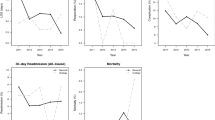Abstract
Purpose
Adrenalectomy is performed to treat functional pathology and remove tumors of malignant concern. The National Surgical Quality Improvement Program (NSQIP) risk calculator predicts 30-day complications and length of stay following index surgical procedures. We assess whether this tool accurately predicts complications following adrenalectomy procedures at a tertiary care academic medical center.
Methods
A retrospective review was performed for all adrenalectomies at a single institution from 2004 to 2016. 197 patients underwent adrenalectomy without concurrent resections. Predicted risk for NSQIP complications was calculated for each patient. The mean predicted and observed risks (%) at 30 days across all patients within each category were determined, and these were compared with two-sided one-sample t tests.
Results
Of 197 adrenalectomies, 180 were laparoscopic and 17 were open. For laparoscopic adrenalectomy, ten (5.5%) complications were observed including nine (5%) graded Clavien III or greater. All observed complication rates were significantly different than predicted (p values for all < 0.005). Mean observed length of stay was also significantly less than predicted (1.6 versus 2.1 days, p < 0.001). In the open adrenalectomy subgroup, there were no observed complications with observed mean length of stay equivalent to predicted (5.8 versus 5.3, p = 0.08) without a higher readmission rate (5.9 versus 6.0%).
Conclusions
Statistical differences were noted between the actual complication rates of adrenalectomy versus those predicted by the NSQIP calculator. Certain observed differences may not necessarily have clinical significance. Urology procedure-specific calculators may better refine predictions for sub-specialty procedures with future work requisite to determine performance across all practice settings.
Similar content being viewed by others
References
American College of Surgeons. https://www.facs.org/quality-programs/acs-nsqip. Accessed 8 June 2019
American College of Surgeons National Surgical Quality Improvement Program. https://riskcalculator.facs.org/RiskCalculator/. Accessed 8 June 2019
Bilimoria KY, Liu Y, Paruch JL, Zhou L, Kmiecik TE, Ko CY, Cohen M (2014) Development and evaluation of the universal ACS NSQIP surgical risk calculator: a decision aide and informed consent tool for patients and surgeons. J Am Coll Surg 217(5):833–842. https://doi.org/10.1016/j.jamcollsurg.2013.07.385
Winoker JS, Paulucci DJ, Anastos H, Waingankar N, Abaza R, Eun DD, Bhandari A, Hemal AK, Sfakianos JP, Badani KK (2017) Predicting complications following robot-assisted partial nephrectomy with the ACS NSQIP® universal surgical risk calculator. J Urol 198(4):803–809. https://doi.org/10.1016/j.juro.2017.04.021
Golan S, Adamsky MA, Johnson SC, Barashi NS, Smith ZL, Rodriguez MV, Liau C, Smith ND, Steinberg GD, Shalhav AL (2018) National Surgical Quality Improvement Program surgical risk calculator poorly predicts complications in patients undergoing radical cystectomy with urinary diversion. Urol Oncol 36(2):77.e1–77.e7. https://doi.org/10.1016/j.urolonc.2017.09.015
Vaziri S, Wilson J, Abbatematteo J, Kubilis P, Chakraborty S, Kshitij K, Hoh DJ (2018) Predictive performance of the American College of Surgeons universal risk calculator in neurosurgical patients. J Neurosurg. 128(3):942–947. https://doi.org/10.3171/2016.11.JNS161377
Rivard C, Nahum R, Slagle E, Duininck M, Isaksson Vogel R, Teoh D (2016) Evaluation of the performance of the ACS NSQIP surgical risk calculator in gynecologic oncology patients undergoing laparotomy. Gynecol Oncol 141(2):281–286. https://doi.org/10.1016/j.ygyno.2016.02.015
Cohen ME, Liu Y, Ko CY, Hall BL (2017) An examination of American College of Surgeons NSQIP surgical risk calculator accuracy. J Am Coll Surg 224(5):787–795.e1. https://doi.org/10.1016/j.jamcollsurg.2016.12.057
Zeiger MA, Thompson GB, Duh QY, Hamrahian AH, Angelos P, Elaraj D, Fishman E, Kharlip J (2009) American Association of Clinical Endocrinologists and American Association of Endocrine Surgeons Medical Guidelines for the Management of Adrenal Incidentalomas: executive summary of recommendations. Endocr Pract 15(5):450–453. https://doi.org/10.4158/EP.15.5.450
Smith CD, Weber CJ, Amerson JR (1999) Laparoscopic adrenalectomy: new gold standard. World J Surg 23(4):389–396
American College of Surgeons National Surgical Quality Improvement Program. https://riskcalculator.facs.org/RiskCalculator/PatientInfo.jsp. Accessed 8 June 2019
Monn MF, Calaway AC, Mellon MJ, Bahler CD, Sundaram CP, Boris RS (2015) Changing USA national trends for adrenalectomy: the influence of surgeon and technique. BJU Int 115(2):288–294. https://doi.org/10.1111/bju.12747
Sood A, Majumder K, Kachroo N, Sammon JD, Abdollah F, Schmid M, Hsu L, Jeong W, Meyer CP, Hanske J, Kalu R, Menon M, Trinh QD (2016) Adverse event rates, timing of complications, and the impact of specialty on outcomes following adrenal surgery: an analysis of 30-day outcome data from the American College of Surgeons National Surgical Quality Improvement Program (ACS-NSQIP). Urology 90:62–68. https://doi.org/10.1016/j.urology.2015.12.031
Parikh PP, Rubio GA, Farra JC, Lew JI (2017) Nationwide analysis of adrenocortical carcinoma reveals higher perioperative morbidity in functional tumors. Am J Surg 216(2):293–298. https://doi.org/10.1016/j.amjsurg.2017.08.018
Brunt LM (2002) The positive impact of laparoscopic adrenalectomy on complications of adrenal surgery. Surg Endosc 16(2):252–257. https://doi.org/10.1007/s00464-001-8302-8
Author information
Authors and Affiliations
Corresponding author
Ethics declarations
Conflict of interest
The authors declare that they have no conflict of interest.
Additional information
Publisher's Note
Springer Nature remains neutral with regard to jurisdictional claims in published maps and institutional affiliations.
Rights and permissions
About this article
Cite this article
Walker, J.B., Gogoj, A., Saunders, B.D. et al. Accuracy of the NSQIP risk calculator for predicting complications following adrenalectomy. Int Urol Nephrol 51, 1291–1295 (2019). https://doi.org/10.1007/s11255-019-02187-1
Received:
Accepted:
Published:
Issue Date:
DOI: https://doi.org/10.1007/s11255-019-02187-1



